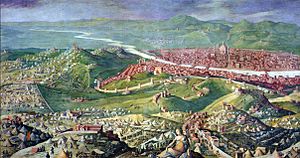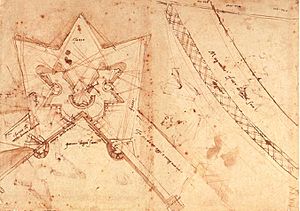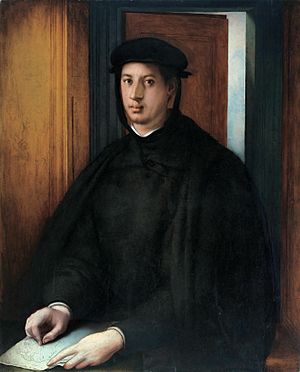Siege of Florence (1529–1530) facts for kids
Quick facts for kids Siege of Florence |
|||||||
|---|---|---|---|---|---|---|---|
| Part of the War of the League of Cognac | |||||||
 The Siege of Florence by Giorgio Vasari 1558 |
|||||||
|
|||||||
| Belligerents | |||||||
| Commanders and leaders | |||||||
The Siege of Florence was a major event that happened from October 24, 1529, to August 10, 1530. It marked the end of the War of the League of Cognac. During this time, the city of Florence, Italy, was surrounded and attacked by a large army.
This army was made up of soldiers from the Holy Roman Empire and Habsburg Spain. They were led by Philibert of Châlon, Prince of Orange. Their goal was to put the powerful Medici family back in charge of Florence. The Medici family had been kicked out of the city a few years earlier.
After almost ten months of fighting, the city of Florence was captured. This ended the Republic of Florence and brought the Medici family back to power. Alessandro de' Medici became the new ruler of the city.
The people of Florence had created their own republic after the Sack of Rome in 1527. They had sided with France in the ongoing war. However, France lost important battles in 1528 and 1529. This led to the French king, Francis I of France, making a peace treaty with Emperor Charles V.
When the Pope Clement VII and the Republic of Venice also made peace with the Emperor, Florence was left alone. Emperor Charles V wanted to please Pope Clement VII, who was a Medici. So, he ordered his armies to take Florence and restore the Medici family.
Florence tried to fight back, but they had no allies left. Many of the hired soldiers they used also betrayed them. After the Imperial forces captured the town of Volterra and their brave commander Francesco Ferruccio was killed, Florence could not fight anymore. The city surrendered in August 1530.
Contents
Why the Siege Happened
After a peace agreement called the Treaty of Bologna in 1529, Emperor Charles V and Pope Clement VII decided to attack Florence. Pope Clement VII was the father of Alessandro de' Medici, who they wanted to put in charge.
The Prince of Orange arrived in Rome in July. The Pope gave him money to attack Perugia and Florence. The Prince of Orange gathered about 7,000 soldiers. These were mostly German soldiers called landsknechts and other Italian groups who were no longer fighting.
Florence prepared for the attack. They gathered almost 10,000 local soldiers and tore down buildings outside their city walls. This was to make it harder for the enemy to hide or attack.
The Prince of Orange marched towards Florence, picking up more soldiers along the way. He needed cannons, so he asked Siena for some. The people of Siena didn't like the Pope much, so they gave the cannons but made them arrive very slowly. By September 24, the Imperial army was still far from Florence, waiting for the cannons.
Inside Florence, there was a lot of confusion. Some leaders wanted to surrender to the Pope. But the main leader, called the gonfaloniere, refused. He insisted that they keep building defenses. Many of the hired military leaders, known as condottieri, refused to fight against the Emperor.
When a nearby town was attacked by the Imperial army, many important Florentine citizens fled. This included Michelangelo Buonarroti, the famous artist and architect. He was in charge of building the city's defenses. He left in September, but came back in November to continue his work until the end of the siege.

The Siege Begins
The strong defenses built by Florence and the delays of the Imperial army made the city determined to fight. On October 5, the Prince of Orange started his march again. By October 24, his army had surrounded Florence. The city had about 8,000 soldiers defending it.
The Imperial army saw that Florence's defenses were too strong for a quick attack. So, they settled into a long siege. They fired cannons at the city and had small fights with the defenders. Many unemployed soldiers from other parts of Italy joined the Imperial army, making it much larger.
The King of France, Francis I, had promised to help Florence. But he did not send any troops, even though his sons had been released from prison. He only sent some money, which he actually owed to Florentine merchants anyway.
Key Battles and Moments
The fighting then moved to the town of Volterra. This town was important for getting supplies to Florence. Imperial forces attacked Volterra. Florence sent Francesco Ferruccio, a brave commander, to help. Ferruccio easily defeated the Imperial troops.
However, Ferruccio did not stay in Volterra as he was ordered. He marched back to Empoli with most of his soldiers. This allowed the Imperial army to attack Volterra again and capture it.
With Volterra lost, Florence's hope of getting supplies into the city became very small. They waited for Ferruccio to arrive with a new army he had gathered near Pisa. The Prince of Orange, knowing that Florence's hired general Malatesta Baglioni would not attack him, marched out to stop Ferruccio.
On August 3, 1530, the two armies met at the Battle of Gavinana. Both the Prince of Orange and Ferruccio were killed in this battle. The Florentine forces were completely defeated.
A Game of Calcio During the Siege
Even during the siege, the people of Florence showed their spirit. On February 17, 1530, they held a game of calcio in Piazza Santa Croce. This was a way to show the Imperial troops that they were not afraid. Only important soldiers, lords, noblemen, and princes played this "noble game."
After the Siege
Even though some citizens wanted to keep fighting, Florence could not continue. Ferruccio's army was destroyed. On August 10, the leaders of Florence surrendered to the Imperial forces. Malatesta Baglioni and his remaining troops left the city.
The Medici family then returned to power in Florence. In the months that followed, many of the leaders of the Republic were either put to death or sent away from the city.
Images for kids
-
The Siege of Florence by Giorgio Vasari 1558
See also
 In Spanish: Sitio de Florencia (1529-1530) para niños
In Spanish: Sitio de Florencia (1529-1530) para niños



